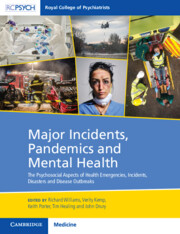 Major Incidents, Pandemics and Mental Health
Major Incidents, Pandemics and Mental Health Book contents
- Major Incidents, Pandemics and Mental Health
- Major Incidents, Pandemics and Mental Health
- Copyright page
- Dedication
- Contents
- Figures
- Tables
- Boxes
- Contributors
- Foreword by Dr Adrian James
- Foreword by Professor David Lockey
- Section 1 The Nature and Impacts of Twenty-First-Century Healthcare Emergencies
- Section 2 Clinical Aspects of Traumatic Injuries, Epidemics, and Pandemics
- Chapter 13 Advances in Pre-Hospital Care
- Chapter 14 The Changing Face of Clinical Medicine in Major Trauma
- Chapter 15 The Changing Face of Traumatic Injury
- Chapter 16 Lessons from History and the Epidemiology of Severe Epidemics and Pandemics
- Chapter 17 The Health Aspects of Epidemics and Pandemics
- Chapter 18 Challenges in Managing Epidemics and Pandemics Illustrated by Ebola and COVID-19
- Section 3 The Role of the Public in Emergencies: Survivors, Bystanders, and Volunteers
- Section 4 Responses to Meet the Mental Health Needs of People Affected by Emergencies, Major Incidents, and Pandemics
- Section 5 Sustaining and Caring for Staff During Emergencies
- Section 6 Designing, Leading, and Managing Responses to Emergencies and Pandemics
- Section 7 Key Lessons for the Way Forward
- A Glossary of Selected Key Terms Used in This Book
- Index
- References
Chapter 15 - The Changing Face of Traumatic Injury
Increasing Experiences of Penetrating Gun and Knife Injuries and Their Treatment
from Section 2 - Clinical Aspects of Traumatic Injuries, Epidemics, and Pandemics
Published online by Cambridge University Press: 11 January 2024
- Major Incidents, Pandemics and Mental Health
- Major Incidents, Pandemics and Mental Health
- Copyright page
- Dedication
- Contents
- Figures
- Tables
- Boxes
- Contributors
- Foreword by Dr Adrian James
- Foreword by Professor David Lockey
- Section 1 The Nature and Impacts of Twenty-First-Century Healthcare Emergencies
- Section 2 Clinical Aspects of Traumatic Injuries, Epidemics, and Pandemics
- Chapter 13 Advances in Pre-Hospital Care
- Chapter 14 The Changing Face of Clinical Medicine in Major Trauma
- Chapter 15 The Changing Face of Traumatic Injury
- Chapter 16 Lessons from History and the Epidemiology of Severe Epidemics and Pandemics
- Chapter 17 The Health Aspects of Epidemics and Pandemics
- Chapter 18 Challenges in Managing Epidemics and Pandemics Illustrated by Ebola and COVID-19
- Section 3 The Role of the Public in Emergencies: Survivors, Bystanders, and Volunteers
- Section 4 Responses to Meet the Mental Health Needs of People Affected by Emergencies, Major Incidents, and Pandemics
- Section 5 Sustaining and Caring for Staff During Emergencies
- Section 6 Designing, Leading, and Managing Responses to Emergencies and Pandemics
- Section 7 Key Lessons for the Way Forward
- A Glossary of Selected Key Terms Used in This Book
- Index
- References
Summary
Injuries caused by knives and bullets frequently produce life-threatening and life-changing injuries, often in urban environments and associated with the abuse of alcohol and drugs. The development of pre-hospital care includes introducing critical care paramedics and critical care response teams, and enhanced assessment techniques. Its success is driven by the concept of scoop and play that is intended to deliver the right patient, with the right treatment, utilising the right transport modality, to the right hospital. Bespoke trauma networks and systems help to meet these objectives. The war in Afghanistan has driven rapid innovation and clinical advances embracing resuscitation, life-saving surgery, and new techniques in trauma reconstruction. These advances have now been introduced into civilian practice and are the backbone of the management of critically injured patients with knife and bullet injuries. Where and when possible, these advances are underpinned by research and delivered by inclusive trauma training.
- Type
- Chapter
- Information
- Major Incidents, Pandemics and Mental HealthThe Psychosocial Aspects of Health Emergencies, Incidents, Disasters and Disease Outbreaks, pp. 99 - 106Publisher: Cambridge University PressPrint publication year: 2024
